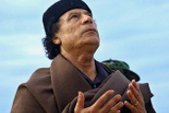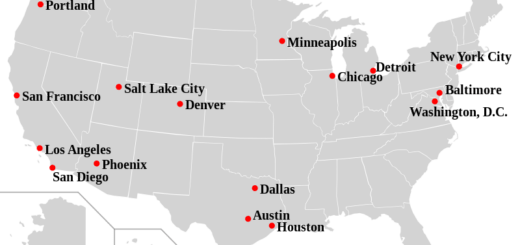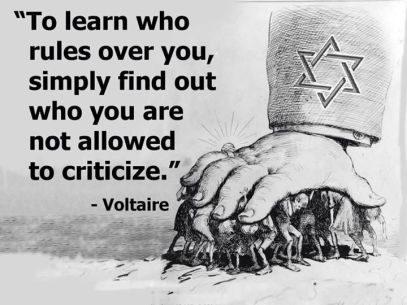Greening the Deserts & Growing Food Should Be A Priority Like It Was For Moammar Qaddafi
Visit to a Farm on the High Desert Plains: A Lesson in Greening the Desert

Traveling by air across Colorado to Grand Junction on the Western Slope of the Rockies, the visitor from the eastern United States takes in two impressive sights: the steep, snow-capped mountains and the other-worldly, almost lunar aspect of the high desert plain. There, the only break in the beige landscape is the green, irrigated—often circular—cropland. And, therein, lies the source of many problems, many disputes, but, also, many opportunities to change the face of agriculture in the desert.
The Grand Valley is just one of many areas in a seven-state region that relies on the Colorado River system for water. Farmers and ranchers irrigate more than 3 million acres of farmland in those states. In 2000, the reservoir system in the Colorado River basin was 95 percent full; as of the fall of 2021, the reservoirs were at 39 percent. As the water crisis unfolds, the demands of urban areas take precedence over agriculture. Some even suggest taking land out of farming in order to conserve water.
While in the Grand Valley recently, we had the opportunity to speak with two brothers who, with another relative, farm approximately 800 acres, crop, and cattle. As they point out, leaving cropland fallow or even allowing bare soil with no plants growing is a waste of the abundance of sunshine available in this area each day. They propose an alternative: crop and graze the land in such a way that the land is itself improved and, as a result, uses less water.
These farmers employ a technique termed regenerative agriculture, which focuses on six principles:
- Know the context of your soil and your system. Clearly, the climate and soil in Colorado are quite different from the climate and soil of, say, Pennsylvania. For example, this area of the West is ancient seabed, saline, yet rich in minerals.
- Use the least amount of chemical and physical disturbance possible. These Grand Valley farmers will use herbicide to eliminate weeds from their cash crops, but their cattle make short work of what remains post-harvest for forage. They also sold their tillage equipment; they don’t plow their fields for planting but follow their harvesting equipment with no-till seeders.
- Keep the soil covered. Along with not plowing the soil, these farmers plant rotational cover crops. The soil is never left fallow.
- Have a diversity of plants and animals. Each will provide their own inputs to the soil.
- Keep living roots in the soil. A resource guide on soil health explains: “Soils need plants to capture carbon from the atmosphere and send it through their roots to feed the multitude of organisms that actively create structures, cycle nutrients, and regulate the water cycle.”
- Integrate animals into the system. In hot, dry Grand Valley, these farmers summer their cattle on leased land in the Mesa and national forest which has plenty of water. Post-harvest, they are back in the Valley where they are moved from field to field so that no one area is overgrazed, a widespread practice called rotational grazing.
We looked at one field that had been no-till seeded with a cover crop including turnips and cold-weather greens. A number of weaned calves were grazing. It happened to be across the road from an uncultivated field of desert with sagebrush. We inspected a shovel-full of dirt: it was a dark brown, teeming with earthworms, roots, and beneficial fungus. These farmers use in-furrow irrigation of water from the Colorado River, but they strongly believe that, since adopting the regenerative agriculture approach, they have decreased their water usage by 10 percent. They have asked the University of Colorado to measure the inflow of irrigation water and rain less the outflow of water not used. And, with that proof of principal, our young farmers hope to convince their fellow ranchers and farmers to adopt these techniques.
This model of regenerative agriculture is very similar to what Lyndon LaRouche proposed over many years for the greening of the deserts in Africa and elsewhere. He was committed to stopping the desertification of vast tracts of arable land and making these deserts bloom. We can imagine Mr. LaRouche looking upon this creative solution to a difficult problem in the high plains desert of the United States and being immensely pleased.
- One of the biggest civilian development project that Libya’s ex-president Muammar Gaddafi undertook during his forty-two-year rule was the Great Man-Made River. Gaddafi’s dream was to provide fresh water for everyone, and to turn the desert green, making Libya self-sufficient in food production.
How Gaddafi’s Great Man-Made River Project became part of Water Wars
by Linda Housman

April 14, 2013 – Libyans called it the eighth wonder of the world. Western media called it a pet project and the pipe dream of a mad dog. The “mad dog” himself in 1991 prophetically said about the largest civil engineering venture in the world: “After this achievement, American threats against Libya will double. The United States will make excuses, but the real reason is to stop this achievement, to keep the people of Libya oppressed.”
Gaddafi’s dream
It was Muammar Gaddafi’s dream to provide fresh water for all Libyans and to make Libya self-sufficient in food production. In 1953, the search for new oilfields in the deserts of southern Libya led to the discovery not just of significant oil reserves, but also of vast quantities of fresh water trapped in the underlying strata. The four ancient water aquifers that were discovered, each had estimated capacities ranging between 4,800 and 20,000 cubic kilometers. Most of this water was collected between 38,000 and 14,000 years ago, though some pockets are believed to be only 7,000 years old.
After Gaddafi and the Free Unitary Officers seized power in a bloodless coup from the corrupt King Idris during the Al-Fateh Revolution in 1969, the Jamahiriya government nationalized the oil companies and spent much of the oil revenues to harness the supply of fresh water from the desert aquifers by putting in hundreds of bore wells. Large farms were established in southern Libya to encourage the people to move to the desert. It turned out that the majority of the people however preferred life in the northern coastal areas.
Therefore Gaddafi subsequently conceived a plan to bring the water to the people instead. The Libyan Jamahiriya government conducted the initial feasibility studies in 1974, and in 1983 the Great Man-Made River Authority was set up. This fully government funded project was designed in five phases, each of them largely separate in itself, but which eventually would combine to form an integrated system. As water in Gaddafi’s Libya was regarded to be a human right, there has not been any charge on the people, nor were any international loans needed for the almost $30 billion cost of the project.
In 1996, during the opening of Phase II of the Great Man-Made River Project, Gaddafi said:
This is the biggest answer to America and all the evil forces who accuse us of being concerned with terrorism. We are only concerned with peace and progress. America is against life and progress; it pushes the world toward darkness.
Development and destruction
At the time of the NATO-led war against Libya in 2011, three phases of the Great Man-Made River Project were completed. The first and largest phase, providing two million cubic metres of water a day along a 1,200 km pipeline to Benghazi and Sirte, was formally inaugurated in August 1991. Phase II includes the delivery of one million cubic metres of water a day to the western coastal belt and also supplies Tripoli. Phase III provides the planned expansion of the existing Phase I system, and supplies Tobruk and the coast from a new wellfield.
The ‘rivers’ are a 4000-kilometer network of 4 meters diameter lined concrete pipes, buried below the desert sands to prevent evaporation. There are 1300 wells, 500,000 sections of pipe, 3700 kilometers of haul roads, and 250 million cubic meters of excavation. All material for the project was locally manufactured. Large reservoirs provide storage, and pumping stations control the flow into the cities.
The last two phases of the project should involve extending the distribution network together. When completed, the irrigation water from the Great Man-Made River would enable about 155,000 hectares of land to be cultivated. Or, as Gaddafi defined, the project would make the desert as green as the flag of the Libyan Jamahiriya.
In 1999, UNESCO accepted Libya’s offer to fund the Great Man-Made River International Water Prize, an award that rewards remarkable scientific research work on water usage in arid areas.
Many foreign nationals worked in Libya on the Great Man-Made River Project for decades. But after the start of NATO’s so-called humanitarian bombing of the North-African country in March 2011, most foreign workers have returned home. In July 2011, NATO not only bombed the Great Man-Made River water supply pipeline near Brega, but also destroyed the factory that produces the pipes to repair it, claiming in justification that it was used as “a military storage facility” and that “rockets were launched from there”. Six of the facility’s security guards were killed in the NATO attack, and the water supply for the 70% of the population who depend on the piped supply for personal use and for irrigation has been compromised with this damage to Libya’s vital infrastructure.
The construction on the last two phases of the Great Man-Made River Project were scheduled to continue over the next two decades, but NATO’s war on Libya has thrown the project’s future – and the wellbeing of the Libyan people – into great jeopardy.
A German language documentary shows the size and brilliance of the project:
Water Wars
Fresh clean water, as provided to the Libyans by the Great Man-Made River, is essential to all life forms. Without fresh water we simply cannot function. Right now, 40% of the global population has little to no access to clean water, and that figure is actually expected to jump to 50% by 2025. According to the United Nations Development Program 2007, global consumption of water is doubling every 20 years, more than twice the rate of human population growth. Simultaneously, every single year most of the major deserts around the world are becoming bigger and the amount of usable agricultural land in most areas is becoming smaller, while rivers, lakes and major underground aquifers around the globe are drying up – except in Gaddafi’s Libya.
In the light of the current world developments, there is more to the NATO destruction of the Great Man-Made River Project than being an isolated war crime. The United Nations Environment Program 2007 describes a so-called “water for profit scheme”, which actively promotes the privatization and monopolization for the world’s water supplies by multinational corporations. Meanwhile the World Bank recently adopted a policy of water privatization and full-cost water pricing, with one of its former directors, Ismail Serageldin, stating: “The wars of the 21st century will be fought over water”.
In practice this means that the United Nations in collaboration with the World Bank plans to secure water resources to use at their disposal, and that once they totally control these resources, the resources become assets to be reallocated back to the enslaved nations for a price. Those prices will rise while the quality of the water will decrease, and fresh water sources will become less accessible to those who desperately need it. Simply put, one of the most effective ways to enslave the people is to take control of their basic daily needs and to take away their self-sufficiency.
How this relates to the NATO destruction of Gaddafi’s Great Man-Made River Project in July 2011 can be best illustrated by the Hegelian Dialectic, popularly known as the concept of Problem -> Reaction -> Solution. In this case, by bombing the water supply and the pipes factory, a Problem was created with an ulterior motive, namely to gain control over the most precious part of Libya’s infrastructure. Subsequently a Reaction in the form of an immediate widespread need was provoked as a result of the Problem, since as much as 70% of the Libyans depend on the Great Man-Made River for personal use as well as for the watering of the land. A month after the destruction of the Great Man-Made River, more than half of Libya was without running water. Ultimately a predetermined Solution was implemented: in order to have access to fresh water, the inhabitants of the war-torn country had no choice but to fully depend on – and thus to be enslaved to – the NATO-installed government.
A ‘democratic’ and ‘democracy-bringing’ government that came to power through the wounding and killing of thousands of Libyans by ‘humanitarian bombs’, and that overthrow the ‘dictator’ whose dream it was to provide fresh water for all Libyans for free.
War is still peace, freedom is still slavery.
Linda Housman
See more at https://english.pravda.ru/history/126361-gaddafi_man_made_river/
Comment: Pictured is Qaddafi one of the Greatest Humanitarians who ever lived who was tortured to death by Terrorists working with NATO.














